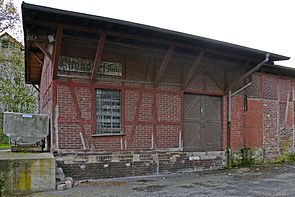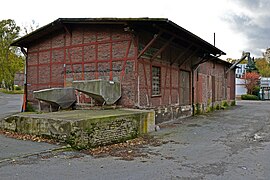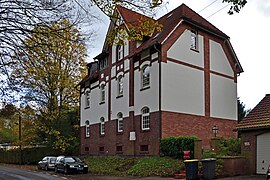Altendorf (Ruhr) station
| Altendorf (Ruhr) | |
|---|---|
|
Preserved station building with lettering
|
|
| Data | |
| Location in the network | Separation station |
| abbreviation | ALR (old) |
| opening | July 1, 1879 |
| Conveyance | May 31, 1959 |
| location | |
| City / municipality | eat |
| Place / district | Burgaltendorf |
| country | North Rhine-Westphalia |
| Country | Germany |
| Coordinates | 51 ° 25 '29 " N , 7 ° 6' 54" E |
| Height ( SO ) | 65 m |
| Railway lines | |
|
|
| Railway stations in North Rhine-Westphalia | |
The Altendorf (Ruhr) station was a passenger station with goods handling in Altendorf an der Ruhr . 1970 Altendorf was at incorporation into the city Essen in Burgaltendorf renamed because it already Altendorf was in the western city.
In addition to the freight traffic for the surrounding hard coal mines, the station served the passenger traffic of two railway lines: the line from Kupferdreh via Überruhr to Dahlhausen and the line from Heißen via Steele Süd to Altendorf (Ruhr).
history
Track construction for the mining industry
In 1863, the first double-track wooden bridge from Altendorf over the Ruhr was built for the transport of coal to neighboring coal mines, which was initially used by a horse-drawn railway. It was popularly called the Roman Bridge and was laid down in 1912.
In 1874, the Bergisch-Märkische Eisenbahn-Gesellschaft built the railway line from Kupferdreh via Überruhr and Altendorf (Ruhr) to Dahlhausen as part of the Middle Ruhr Valley Railway . In this context, the construction of the initially single-track railway bridge Dahlhausen over the Ruhr took place, although there was still no train station in Altendorf (Ruhr). Even before it was built, Altendorf had a rail link to the United Charlotte colliery for the purpose of transporting coal.
As a second route, the Mülheim-Heißen-Altendorf (Ruhr) railway was connected to Altendorf by the Rheinische Eisenbahn-Gesellschaft , starting from Heißen , on January 21, 1879, initially for freight traffic, thus creating the Altendorf (Ruhr) station. This Rhenish railway line was opened from Heißen to Rellinghausen on September 20, 1872 . On June 15, 1872 the extension to Steele South was added. Finally, when the railway bridge over the Ruhr was completed in 1879, Altendorf was connected. In addition, the Rheinische Bahn established an eastern freight transport connection to the Altendorf civil engineering colliery .
![]()
Station complex
Passenger traffic and the Altendorf (Ruhr) train station were opened on July 1, 1879. A simple, wooden shelter initially served the travelers. Starting in October of that year, three passenger trains per day drove over the Rhenish railway line. In the meantime, all railway lines were operated by the Prussian State Railways. In the years 1888 and 1889 a station building was built, which replaced the first wooden structure and was rebuilt and expanded several times in the following years. From around 1900 the building had two waiting rooms, an office for the station master and a ticket office with a platform lock, supplemented by a ramp for piece goods.
The switches and signals of the multi-track station area were controlled by two signal boxes. In the house opposite, Holteyer Straße 122, there was what was then known as the restoration for the station . To the west, on the south side of Holteyer Strasse, there is the house with number 155, which had official apartments for the railway workers.
During the occupation of the Ruhr from January 1923 to November 1924 in the time of the Weimar Republic , the Altendorfer station became quiet, as all available trains were on their way from the occupiers to France and Belgium to provide reparations . Five steam locomotives and nine passenger cars were detained on the tracks of the United Charlotte colliery and serviced there. Emergency traffic was thus maintained. One year after the occupation there were first considerations to shut down the personal connection to Steele South. These were not implemented. In contrast, in 1927 the Dahlhauser Bridge was extended by a second track. In the period that followed, the speeds had to be reduced to 10 km / h due to inadequate route maintenance. For a short time, deliveries of filter sand for water extraction in the Ruhr valley brought a certain upturn in the 1930s, as the track systems had to be adapted accordingly for this high level of stress.
After the war
Towards the end of the Second World War in 1945, the two-track steel truss bridge to Dahlhausen, which had been in use since 1927, was blown up by the Germans and, after a single-track reconstruction, put into service again in 1951. The Ruhr bridge on the route from Steele Süd was also blown up by Germans on April 2, 1945, but was never rebuilt. This connection remained interrupted.
After the war, passenger traffic was established from Altendorf (Ruhr) station via Überruhr, Kupferdreh , Heisingen and Werden to Kettwig , which was used to a large extent by commuting miners. In addition, there was a brief stop at the Zeche Theodor (ZTH), the successor to the United Charlotte mine. The Deutsche Bundesbahn now used Wittfeld accumulator railcars of the ETA 177 series as locomotives.
![]()
On May 31, 1959, this line was finally shut down after Überruhr and passenger traffic ended at Altendorf (Ruhr) station. The track systems of the Theodor colliery were still connected to Dahlhausen through the Altendorf (Ruhr) station until it was closed in 1968 for the purpose of transporting coal.
Todays situation
The industrial area north of the train station, which still exists today, was created through the settlement of companies with rail connections from the 1880s. After the closure of the railway line from Überruhr to Altendorf in 1959 and the nearby Theodor colliery, which was closed in 1968, its route is hardly recognizable today.
Occasional traffic over the railway bridge to Dahlhausen was still irregular, used by the local railway museum , among other things .
All track systems were dismantled in 1991. The single-track railway bridge to Dahlhausen, which was rebuilt after the war, has been preserved without tracks. The house in Holteyer Straße 122, which temporarily housed the train station restaurant, and the house of the former railway workers' service apartments at number 155 are now residential buildings.
The former station building of the Altendorf (Ruhr) station is now used as a warehouse in a completely different design by a building materials dealer, as well as a dispatch building located north of it.
Web links
NRWbahnarchiv by André Joost:
further evidence:
- Heimat- und Burgverein Essen-Burgaltendorf e. V. - Burgaltendorf's railway history ; Retrieved November 11, 2013
Individual evidence
- ↑ Martin Bünermann: The communities of the first reorganization program in North Rhine-Westphalia . Deutscher Gemeindeverlag, Cologne 1970, p. 112 .
- ^ Operational archive of André Joost, junction Zeche Theodor





